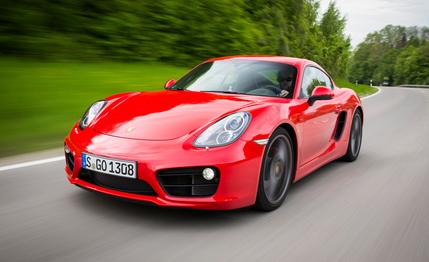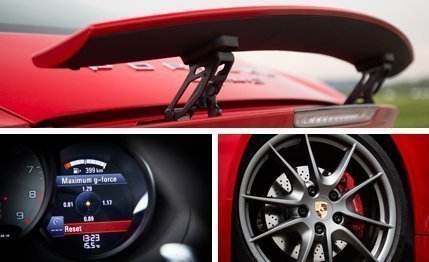 Instrumented Test
Instrumented Test
You have to keep reminding yourself while dusting switchbacks in the Austrian Alps with the new Porsche Cayman S that this is not your dream car. This is not the 911 Carrera, the car in the posters that once wallpapered your bedroom. If the 911 has always been your best friend, your trusty go-to, your touchstone and ne plus ultra in a world flooded with automotive mediocrity, then, well, you’re just going to have to let that go. The Cayman is all grown up now, and your attention is about to be whipsawed. The 911, er, what? Who?
Tacking into a steep valley toward the empty ski village of Warth, 4905 feet up the slopes of Western Austria, where the landscape looks as meticulously manicured as a model-train set’s, the Cayman S feels organic, like it’s somehow more animal than mechanical. You shake hands with it. The handshake is firm.
There’s no twitchiness or uncertainty in the steering; on-center is just that; and there’s no slack, no delay in response. Left and right happen right now.
Linking corners is a laminar event, one flowing into the other on a seamless wave of confidence at every entry, apex, and exit. Clicking off the instant, paddle-controlled downshifts broadcasts the Cayman’s passing with a warble from the twin pipes.

It isn’t until we reach a straight road leading away from the rapeseed farm where we borrow an ancient agricultural scale to weigh the Cayman (3131 pounds) that our epiphany happens: This may be the best a Porsche ever gets. Instead of an agricultural scale, this car should be measured on the Enhanced Fujita scale.
Porsche has slowly closed the gap between its mid- and rear-engined models since the debut of the 2006 Cayman, known internally as the 987. Both model lines, the Cayman and the Carrera, went on a diet of aluminum before the current versions were introduced. In the new Cayman, code-named the 981, the hood, doors, front fenders, floors, and hatch are all alloy.
The Cayman is still a fixed-roof version of the Boxster, and snapping the cap on the roadster increases its torsional rigidity by 40 percent. Despite modest dimensional growth, Porsche claims that this car is slightly lighter than its predecessor. In fact, our Guards Red automatic Cayman S is nearly 100 pounds heavier than the last Cayman S we tested, though that car was a manual. So we’re not yet ready to dismiss Porsche’s claim.
The base 911 and the Cayman S share a 3.4-liter flat-six, though the mid-engined model’s is detuned to 325 horsepower from 350. Torque is down, too, from 287 pound-feet in the Carrera to 272 here.